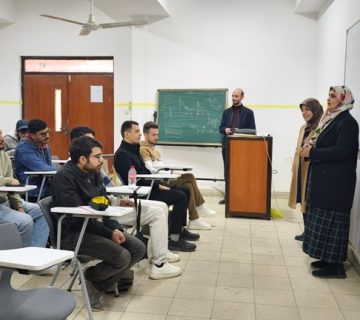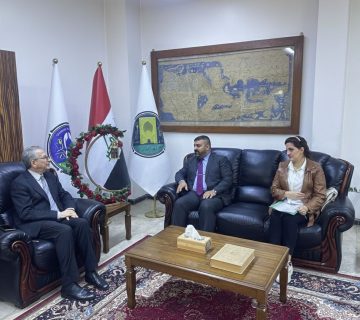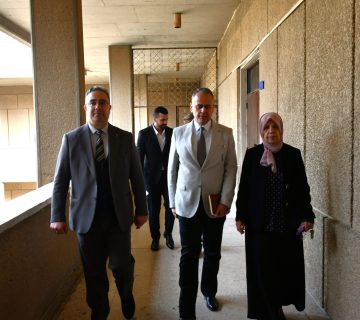Environmental Engineering Department at the College of Engineering, University of Baghdad, held PhD dissertation examination on Wednesday 21/6/2023 titled:
“Adsorptive performance of CuMgAl-LDH/MMt in Pb2+, Cd2+, and Zn2+ ions from aqueous solution. Batch and circulated fluidized bed”
By the student Fatin Abdulkadhim Mohammed Ali and supervised by Prof. Dr Ahmed Abd Mohammed and Assist Prof. Dr. Tarik Jawad Kadhim. The examination committee consisted of Prof. Dr. Mohaned Jasim Mohammed Ridha as Chairman, and the membership of Prof. Dr. Ali Hussein Abbar, Prof. Dr. Ziyad Tarik Abd Ali, Assist. Prof. Dr. Jathwa Abdulkareem Ibrahim, and Assist. Prof. Dr. Sabreen Kadhim Lateef. After conducting the public discussion and listening to the student’s defense, the dissertation was accepted. It was summarized as follows:
Developing an effective adsorbent for removing heavy metals is an interesting field in water and wastewater treatment research. This work successfully prepared and applied a triple metal-layered double hydroxide/montmorillonite composite () by co-precipitation method for the adsorption of Zinc (), Cadmium (), and lead () ions from an aqueous solution in batch and continuous circulating fluidized bed systems (). A , , , / , and analysis were utilized to characterization of , , and adsorbent. In the batch system; the effects of pH–solution, contact time, dosage, agitation speed, particle size, initial concentration, and temperature on the metal ions adsorption were investigated. The maximum adsorption efficiency was found at pH 5 for both and and pH 6 for at initial metal ions concentration 70 mg/L. The adsorption process was reached to equilibrium time at 90 min for each metal ions. The optimal adsorbent dosage for the above conditions was 0.25 mg/l for and 0.2 mg/l for , and removal. The adsorption efficiency decreased with increasing temperature; this means that the mechanism of metal ions adsorption mainly involves exothermic and spontaneous processes. From the Langmuir model, the composite had a maximum adsorption capacity of 154.21mg/g for , 129.82 for , and 132.85 for adsorption. A pseudo-second-order kinetic model presented a better simulation of the kinetic experimental data and the adsorption rate parameter values, indicating that the adsorption of metal ions process was chemisorption. While the intraparticle diffusion model explains that the entire kinetic process of heavy metal ions diffusion is controlled by three adsorption mechanisms. Regeneration process were carried out, CuMgAl-LDH/MMt adsorbent can be recovered after five consecutive cycles. Optimization by using RSM-CCD was performed to study the effective factors on the adsorption efficiency (response). The relation between the model response and the independent parameters is expressed by a quadratic mathematical equation, then the regression equations of model were represented as 3D surface and 2D contour designs graphs. For the continuous metal ion removal, a circulated fluidized bed reactor was installed, and the effects of different operating conditions were investigated, such as static bed height (2, 3 and 5 cm); liquid flow rate (300, 350, and 400) ml/min; and initial ion concentrations (25, 50 and 100) mg/L for , , and ions. The time required to reach saturation condition was decreases as liquid flow rate increased, bed depth decreased initial concentration decreased and air flow rate increased. Hydrodynamic parameters were studied by determined of pressure drop and minimum liquid fluidized velocity, Bed-expansion ratio, and Phase’s holdup. The dynamic behavior of fluidized bed and breakthrough curve analysis was evaluated by calculating of total mass of metal adsorbed, the total removal efficiency of the column, and equilibrium of metal ions concentration. The adsorption capacity (qe) of the column increased as liquid and airflow rates increased, indicating that qe is directly proportional to the influent liquid and airflow to the column. A three nonlinear column models were studied to predict the column kinetic constants and adsorption capacity of the fluidized-bed columns. The results proved Adams–Bohart model could represent the initial regime of the breakthrough-curves, while Thomas model was better for describing the whole curve of metal ion adsorption. The mass transfer coefficient in continuous systems was estimated.








